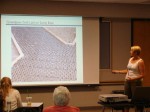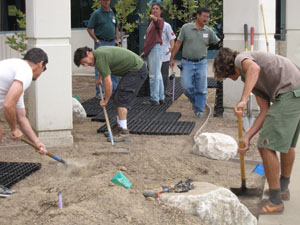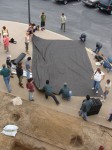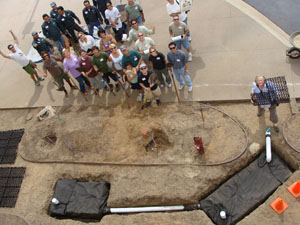The installation of the Edward C. Little Water Recycling Facility Ocean Friendly Garden is underway by G3 Associate, Barbara Engel of LA-based C-27, Sunshine Greenery.
Today, however, the community has been invited to learn about the installation of two kinds of rainwater capture and pollution prevention techniques: (1) Installing permeable gravel paving, and (2) Installing subterranean infiltration devices. The day began in a classroom, where G3 Founding Member, Pamela Berstler, reviewed the progress to date and gave a play-by-play about what was going to happen in the field.
Then, everyone headed outside to start installing the paving. The objective of the day is to demonstrate how simple techniques can be used in any landscape to retain 1,200 gallons or more of water per rain event. The roof of the adjacent building is nearly 8,000 sq. ft., but the retention devices are designed to hold the water from a 2,000 sq. ft. (a typical large residential building) roof. (Approximately 620 gallons of water can be gathered from 1,000 sq. ft. of surface per inch of rainfall.) Participants in this event included homeowners and professionals, including the team from Sunshine Greenery. G3 Certified Professionals, Marianne Simon, Ben Allanoff, Steve Williams, and Daniel Kramer put their heads and hands together to level the grade and snap together the EcoRain Drainage Cells supporting the gravel paving that constitutes the ADA-compliant walkway through the new garden.
The Drainage Cells provide void space allowing water to be held in the pathway temporarily and slowly dispersed throughout the garden. This slowing down and spreading out of the stormwater, helps prevent the runoff of the First Flush, or first 3/4″ – 1″ of rain water after a dry spell.
Once the paving is completed, everyone gets involved installing the subterranean infiltration devices. The whole group lays out the non-woven geotextile that will wrap the boxes and keep soil and debris from clogging up the void space within them. Just like in sewing, guys, MEASURE TWICE and CUT ONCE!
The basins are wrapped in geotextile with holes cut out for pipes to connect basins and provide maintenance ports. Note how the two basins are connected via a pipe, with an overflow that eventually allows excess water to flow off site.





